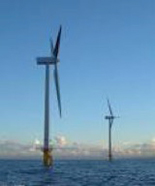 ESR4: Probabilistic optimisation of the design of offshore wind turbine towers
ESR4: Probabilistic optimisation of the design of offshore wind turbine towers
- Host: Trinity College Dublin (TCD)
- Address: School of Civil, Structural and Environmental Engineering; TCD, College Green, Dublin 2, Ireland.
- Main Supervisor: Prof. Alan O’Connor
- Fellow: Rui Teixeira
The growth of the global wind energy sector is undisputable with 215GW of installed capacity as of June 2011 (over 100 times the installed capacity of 1990). As the industry strives to innovate by reducing the unit price of wind generated electricity there is an ever-increasing requirement for research in this domain. Current models are rated up to 7.5MW with hub heights of up to 150m. Due to the wind shear effect, taller hub-heights result in greater and more stable wind inflow speeds. Coupled with the fact that larger turbine units will generate greater amounts of electricity, this means that wind turbine sizes will tend to increase for the foreseeable future.
As these hub heights increase, the size of the wind turbine units they support continue to get larger, wind farms are located in more severe offshore environments and in active seismic zones, the necessity to employ advanced design techniques, such as probabilistic methods, to optimize structural design becomes apparent.
This project involves a secondment of a few months to Lloyd’s Register (supervised by Dr. Banisoleiman) at their locations in both London and Aberdeen. Based on their experience, Lloyd’s Register have produced guidance documents covering all aspects of wind farm certification from initial design through construction and onto operation. The ESR will gain expertise in the treatment of safety issues related to load and capacity, and in particular, that based on the concept of limit states to address here for wind turbines through reliability approaches. The ESR has also experienced another secondment in Phimeca Engineering (supervised by Dr. Yalamas) to improve his knowledge on the use of specialised software for reliability analysis.
You can follow blog and publications by ESR4 below.



